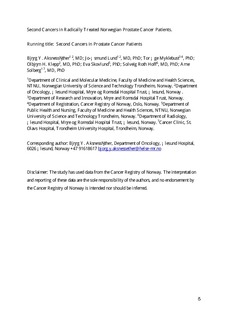| dc.contributor.author | Aksnessæther, Bjørg Yksnøy | |
| dc.contributor.author | Lund, Jo-Åsmund | |
| dc.contributor.author | Myklebust, Tor Åge | |
| dc.contributor.author | Klepp, Olbjørn | |
| dc.contributor.author | Skovlund, Eva | |
| dc.contributor.author | Hoff, Solveig Roth | |
| dc.contributor.author | Solberg, Arne | |
| dc.date.accessioned | 2020-03-03T07:37:42Z | |
| dc.date.available | 2020-03-03T07:37:42Z | |
| dc.date.created | 2019-06-07T13:22:28Z | |
| dc.date.issued | 2019 | |
| dc.identifier.citation | Acta Oncologica. 2019, 58 (6), 838-844. | nb_NO |
| dc.identifier.issn | 0284-186X | |
| dc.identifier.uri | http://hdl.handle.net/11250/2644780 | |
| dc.description.abstract | Introduction: The aim of this registry-based cohort study was to estimate second cancer (SC) risk following radical prostate cancer (PC) treatment and evaluate if the risk was influenced by radiotherapy.
Materials and methods: We collected data from the Cancer Registry of Norway on all patients with PC as first cancer diagnosis, from 1997 to 2014. Standardized incidence ratios (SIRs) for SC were calculated by comparing our cohort to the standard male population. Subdistribution hazard ratios were estimated in treatment groups, using patients treated with radical prostatectomy (RP) as reference.
Results: We analyzed 24,592 radically treated PC patients. The median follow-up was 7.75 and 6.25 years in the external beam radiotherapy (EBRT) and RP-groups, respectively. SIR for SC was indifferent from the reference population in 24,592 radically treated patients, higher following EBRT, SIR 1.12 (1.07–1.17), and lower following RP, SIR 0.93 (0.87–0.99). EBRT treated patients had higher rectal and urinary bladder cancer incidences, SIR 1.38 (1.16–1.64) and 1.49 (1.31–1.69), respectively. The EBRT patients and the patients treated with radiation after RP (RT after RP) had 38 and 27% higher risk of any SC. We found higher risk of bladder cancer for all treatment groups as compared to RP patients. Only EBRT treated patients showed higher risk of rectal and lung cancer.
Discussion/conclusions: In our study, we found that PC patients treated with EBRT had an increased incidence of SC compared to the general population. Patients treated with EBRT and RT after RP were found to have increased risk of SCs, using RP patients as reference. The risks of rectal and urinary bladder cancer in patients receiving EBRT were higher compared to both the general population and to patients treated with radical prostatectomy. The risk of SC should be taken into account when discussing treatment for patients and designing follow-up. | nb_NO |
| dc.language.iso | eng | nb_NO |
| dc.publisher | Taylor & Francis | nb_NO |
| dc.title | Second cancers in radically treated Norwegian prostate cancer patients | nb_NO |
| dc.type | Journal article | nb_NO |
| dc.type | Peer reviewed | nb_NO |
| dc.description.version | acceptedVersion | nb_NO |
| dc.source.pagenumber | 838-844 | nb_NO |
| dc.source.volume | 58 | nb_NO |
| dc.source.journal | Acta Oncologica | nb_NO |
| dc.source.issue | 6 | nb_NO |
| dc.identifier.doi | 10.1080/0284186X.2019.1581377 | |
| dc.identifier.cristin | 1703485 | |
| dc.description.localcode | Locked until 25 March 2020 due to copyright restrictions. This is an Accepted Manuscript of an article published by Taylor & Francis in Acta Oncologica on 25 March 2019, available at https://doi.org/10.1080/0284186X.2019.1581377. | nb_NO |
| cristin.unitcode | 194,65,15,0 | |
| cristin.unitcode | 194,65,20,0 | |
| cristin.unitcode | 1920,12,0,0 | |
| cristin.unitname | Institutt for klinisk og molekylær medisin | |
| cristin.unitname | Institutt for samfunnsmedisin og sykepleie | |
| cristin.unitname | Kreftklinikken | |
| cristin.ispublished | true | |
| cristin.fulltext | postprint | |
| cristin.qualitycode | 1 | |
